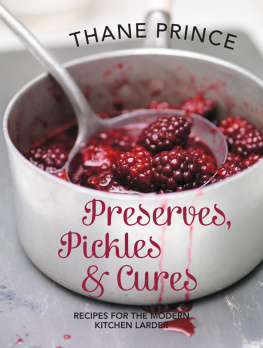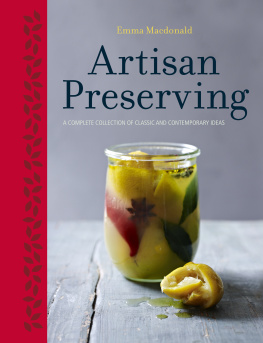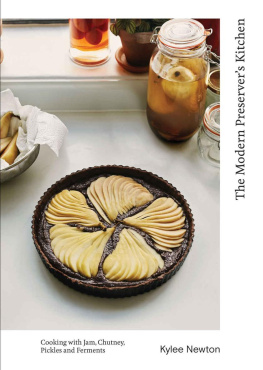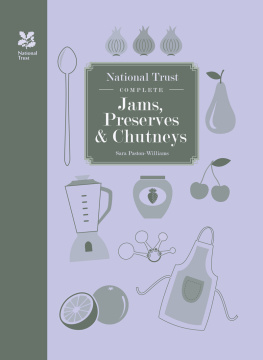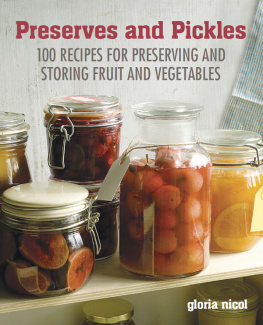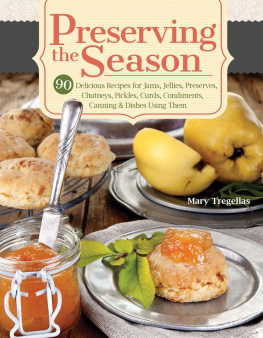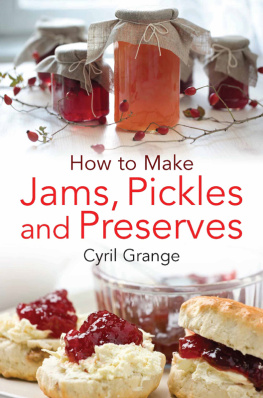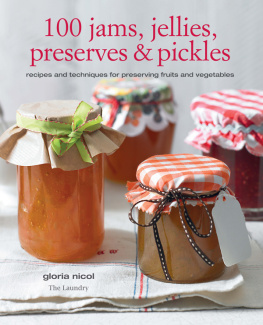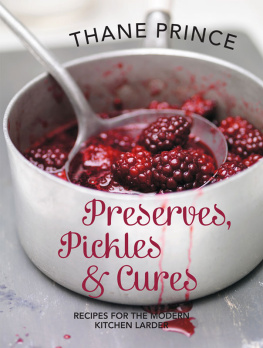Preserves, Pickles & Cures


Preserves, Pickles & Cures
THANE PRINCE
PHOTOGRAPHY BY DIANA MILLER
ILLUSTRATIONS BY SUE ROBSON

Contents

T here is something quite remarkable about the world of larders. Billy Bunter loved larders, full of treats for high teas; Huckleberry Finn raided his Aunt Pollys larder and had to paint her fence in recompense. The very word conjures up in ones mind a place of plenty and delight. That this is still true is quite remarkable in this age of 24-hour shopping, with markets, supermarkets, specialist cheese shops and on-line grocery orders.
We are, wherever we live, seldom more than a few miles or a click of the mouse from any number of cooking essentials or delicious treats, so why the nostalgia for a small, shelved room situated on the north side of the house, filled with strange often unmarked jars, the odd musty smell of ripened fruit and a distinct chill in the air?
I think our yearning for larders, and it is not uncommon for this to be the deciding factor when choosing a new home, is due to a longing for certainty in our wonderful but frantic world. Everything is transient, available and allowed. How nice then to remember and recreate a space where things are stored, left to mature, kept for special occasions and emergencies, a place where life moves slowly and with purpose. Where thrift and economy go hand-in-hand with the skill of a good housekeeper.
It is no coincidence that the rise in larders accompanies the quest for allotments, and a yearning to grow ones own food, keep a few chickens, and even a return to the idea of a cottage pig. The rediscovery of the flavours of home-made, home-grown food has brought about a change in the way we regard our store-cupboards for just as home-cooked food is delicious, home-preserved food can also be wonderful. And what better time to take up this mantle, for now home-preserving accompanies home cooking, and all with splendid produce. Not for us the simple need to fill our larders with all that the garden produced, no matter the quality, in order to survive the winter, but the luxury of choice in what we preserve.
Only the best and ripest fruit and vegetables, only the most carefully raised cured meats, the artisan cheeses, perhaps those special tins of fish bought when in Spain, spice mixes from North Africa, in all a room stocked with undreamt of delights. So although the allure of the pantry is now more about the exotic than the staple, those staples must be considered too. And even with staples there are good choices to be made. There has been, over recent years, a heartening rise in the number of people bringing traditional food production methods back into use, and also bringing those methods up to date. Mills grind local grains into flours and seeds into oils, vinegar is made from local apples, and a British balsamic-type cider vinegar is being made in Suffolk. Any number of small producers make artisan cordials, pickles, jams and mustards. Stocking your larder could then be a simple matter of buying well, as you visit farmers markets and delicatessens. But to simply stock your larder with bought produce is to miss the very real sense of satisfaction that comes from making your own.
For cooking your own preserves, salting and curing your own meats, and bottling your own cordials to stock your larder shelves, is well within the reach of even the beginner in the kitchen.
The recipes in this book have been tested with that very much in mind, and if a few simple rules are followed, you will amaze and impress your family and friends.
The Perfect Larder or Pantry
If you are lucky enough to have found a house with a pantry or larder still intact a great many were knocked out at the advent of good refrigeration then you are blessed indeed. I am assured that these days a larder can add thousand pounds worth of value to homes as more and more people recognise their merit.
The essence of a larder is a north-facing room, and it is best with two outside walls. The ventilation should be through airbricks, one top and one bottom, both covered with fine, fly-proof mesh. The main shelving can be of wood but there must always be a marble slab. This slab is the very soul of the larder: as I write, I see a ham covered with cheesecloth, a hunk of Stilton or Cheddar, some bottles of squash and a bread crock sitting on top of the slab.
The larder should be easy to clean and as the focus is on cold, dry storage, a slate or stone floor is best. No natural light is needed; in fact dark cold is what you most require. Baskets for potatoes and root vegetables can be arranged under the marble slab and dried herbs and salamis can be hung from ceiling hooks.
A pantry is what many more of us can achieve. The definition of pantry is a small room, more likely a cupboard, with the capacity to store food. Many modern kitchens have wonderful pantry cupboards built into them complete with granite slab to recreate the feel of a larder. Whilst these are often very beautiful additions to the kitchen, they do not possess the main feature of a larder, which is its low temperature. A cupboard in a centrally heated room, no matter how well designed, whilst accommodating many foodstuffs, will have to be accompanied by a larger fridge than that needed if you have a cold room or larder.
You can of course be inventive in your search for a larder. I have a friend who uses her cellar: its dark and cold though a little damp, so again you must take care what you store there. If the cellar can be well ventilated it can be a perfect place to store root vegetables, apples, pears and whole hams etc. Out-houses can be perfect, but they still need the essential qualities of cold, dry and dark. You must also make sure they are bug-free and that there is no access for rodents!
A Return to Traditional Skills
Along with the loss of our larders came the loss of many of the essential skills needed to prepare and preserve food. It was once a source of great pride to any housewife that her larder was well ordered, well stocked and a credit to her home-making skills.
Old cookery books, for instance, place great store on thrift. The need to husband and preserve all remnants of fat is particularly fascinating. Fat make an excellent vehicle for storing preserved foods, and in history fats were most careful rendered and stored. This appreciation of fat is somewhat agin the modern way, which can often seem to be looking at those two stalwarts of the traditional larder fat and salt as public enemies. It is a source of some amusement to me that at a time when we lived on highly salted, fatty foods we had much less obesity than now when the horror of low-fat foods congests our fridges.
The ability to source, cook and store food for the family was once essential knowledge handed from mother to daughter. Jane Austen writes of the Bennet girls gathering and drying herbs, Tudor housewives guarded their receipts carefully, and a generation of cookery teachers tried to inspire a love of food and basic skills to often uninterested girls. I remember my own cookery lessons with dismay. The food seemed dull and the rules excessive. Im afraid I didnt shine...
Next page
